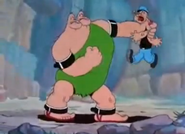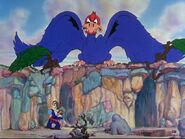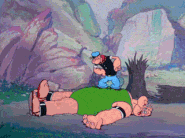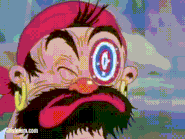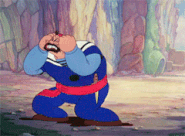| Popeye the Sailor Meets Sindbad the Sailor | |
| Number 41 | |
| Guide | |
| previous The Spinach Roadster |
next I'm in the Army Now |
Popeye the Sailor Meets Sindbad the Sailor is the 41st Popeye cartoon and the first of three Popeye Color Specials. Overall, it was the first Popeye cartoon filmed in color. In this case, the color process used is Technicolor.
A two-reel animated cartoon short subject, it was released to theaters on November 27, 1936 by Paramount Pictures, produced by Max Fleischer for Fleischer Studios, Inc. and directed by Dave Fleischer, with musical supervision by Sammy Timberg. The voice of Popeye is performed by Jack Mercer, with Mae Questel as Olive Oyl and Gus Wickie as Sindbad the Sailor.
Plot[]
In this short, Sindbad the Sailor (who is intended to be an alternate version of Bluto, the nemesis of Popeye) proclaims himself, in song, to be the greatest sailor, adventurer and lover in the world, a handsome bloke, and "the most remarkable, extraordinary fellow", a claim which is challenged by Popeye's arrival to his island with Olive Oyl and J. Wellington Wimpy in tow. Sindbad orders his huge roc, Rokh, to kidnap Popeye's sweetheart, and treats the one-eyed sailor to a series of challenges to prove his greatness, including fighting Rokh, a two-headed giant named Boola, and Sindbad himself. Popeye makes short work of the bird and the giant, but Sindbad almost gets the best of him until the spinach-gulping Sailorman produces a can of his nutritious greens, which gives him the edge to soundly defeat Sindbad, aided by his Twisker Sock, and proclaim himself "the most remarkable, extraordinary fellow."
Trivia[]
- A subtly dark running gag features hamburger-loving Wimpy chasing after a duck on the island with a meat grinder, intending to slaughter the bird and grind its meat so that he can fry it up into his favorite dish. However, not only does the duck escape, but it also snatches away Wimpy's last burger in retaliation after he gives up.
- Many of the scenes in this short film make use of the Fleischers' Tabletop process, which used model sets to create 3D backgrounds for the cartoon.
- Nominated for the 1936 Academy Award for Best Short Subject.
- Famous Studios' 1952 entry Big Bad Sindbad is mosty made up of reused footage from this cartoon, along with some new animation. A shorter sample was also included in 1944's Spinach Packin' Popeye.
- This is the only Popeye short to include the cast of characters.
Gallery[]
External links[]
- Popeye the Sailor Meets Sindbad the Sailor at the Internet Movie Database






